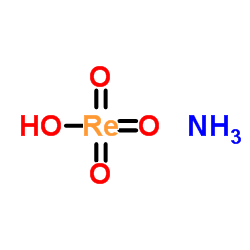ammonium perrhenate

ammonium perrhenate structure
|
Common Name | ammonium perrhenate | ||
|---|---|---|---|---|
| CAS Number | 13598-65-7 | Molecular Weight | 268.243 | |
| Density | 3.97 g/mL at 25 °C(lit.) | Boiling Point | N/A | |
| Molecular Formula | H4NO4Re | Melting Point | N/A | |
| MSDS | Chinese USA | Flash Point | N/A | |
| Symbol |


GHS03, GHS07 |
Signal Word | Danger | |
|
Implication of cysteine residues in the selection of oxorhenium inhibitors of cyclophilin hCyp18.
Metallomics 4(2) , 179-87, (2012) The dynamic combinatorial assembly of libraries of modular cyclophilin hCyp18 oxorhenium inhibitors of general formula [A˙ReO˙B] was accelerated by addition of increasing concentrations of hCyp18 ('Cyclophilin Enhancing Effect', CEE). This result suggested th... |
|
|
Immobilization, trapping, and anion exchange of perrhenate ion using copper-based tripodal complexes.
Inorg. Chem. 50(19) , 9499-507, (2011) We describe a multidentate tripodal ligand in which three pendant arms carrying di(2-picolyl)amine units are linked to the ortho positions of a tris(o-xylyl) scaffold, providing N(CH(2)-o-C(6)H(4)CH(2)N(CH(2)py)(2))(3) (L). Reaction of L with CuCl(2) in the p... |
|
|
Synthesis of oxorhenium(V) complexes with diamido amine ancillary ligands and their role in oxygen atom transfer catalysis.
Inorg. Chem. 48(23) , 11058-66, (2009) The detailed syntheses of complexes of the form [Re(O)(X)(RNCH(2)CH(2))(2)N(Me)] (X = Me, Cl, I, R = mesityl, C(6)F(5)), 1-3, incorporating diamidoamine ancillary ligands are described. X-ray crystal structures for the complexes [Re(O)(Me)((C(6)F(5))NCH(2)CH(... |
|
|
An easily accessible Re-based catalyst for the selective conversion of methanol: evidence for an unprecedented active site structure through combined operando techniques.
Chem. Commun. (Camb.) 47(14) , 4285-7, (2011) Heterogeneous Re/SiO(2) catalysts prepared using a one pot sol-gel synthesis were found to display high activity in the direct, selective methanol conversion to methylal, which is correlated to an unprecedented rhenium oxide structure. |
|
|
Heterometallic cerium(IV) perrhenate, permanganate, and molybdate complexes supported by the imidodiphosphinate ligand [N(i-Pr2PO)2]-.
Inorg. Chem. 52(5) , 2556-63, (2013) Heterometallic cerium(IV) perrhenate, permanganate, and molybdate complexes containing the imidodiphosphinate ligand [N(i-Pr2PO)2](-) have been synthesized, and their reactivity was investigated. Treatment of Ce[N(i-Pr2PO)2]3Cl (1) with AgMO4 (M = Re, Mn) aff... |
|
|
Synthesis, in vitro screening and in vivo evaluation of cyclic RGD analogs cyclized through oxorhenium and oxotechnetium coordination.
Eur. J. Med. Chem. 46(5) , 1779-88, (2011) A library of RGD tripeptide analogs cyclized through oxorhenium coordination by an NS2/S chelation motif was synthesized. Screening towards integrins αVβ3, αIIbβ3 and αVβ5 led to the identification of 6 oxorhenium complexes that bind to integrin αVβ3 in the s... |
|
|
Rh2O3 versus IrO2: relativistic effects and the stability of Ir4+.
J. Phys. Condens. Matter 24(21) , 215503, (2012) Despite the wide-ranging applications of binary Rh and Ir oxides, their stability and trends in Rh and Ir oxidation states are not fully understood. Using first-principles electronic structure calculations, we demonstrate that the origin of the categorical st... |
|
|
Stealth rare earth oxide nanodiscs for magnetic resonance imaging.
Adv. Healthc. Mater. 1(4) , 437-42, (2012) Configuring RE(2) O(3) nanocrystals with pseudo-2D morphologies confers substantive gains in relaxivities over equivalent spherical counterparts. The most promising arises from Gd(2) O(3) whose ionic transverse and longitudinal relaxivities were as high as r(... |
|
|
Intracellular anion fluorescence assay for sodium/iodide symporter substrates
Anal. Biochem. 415(1) , 32-8, (2011) The sodium/iodide symporter (NIS) is primarily responsible for iodide accumulation in the thyroid gland for the synthesis of thyroid hormones; however, it can also transport other lyotropic anions in the thyroid gland and nonthyroid tissues. Some NIS substrat... |
|
|
Evaluation of [18F]-tetrafluoroborate as a potential PET imaging agent for the human sodium/iodide symporter in a new colon carcinoma cell line, HCT116, expressing hNIS.
Nucl. Med. Commun. 32(2) , 98-105, (2011) Accumulation of iodide and other substrates via the human sodium/iodide symporter (hNIS) is fundamental to imaging and therapy of thyroid disease, hNIS reporter gene imaging and hNIS-mediated gene therapy. There is no readily available positron emission tomog... |